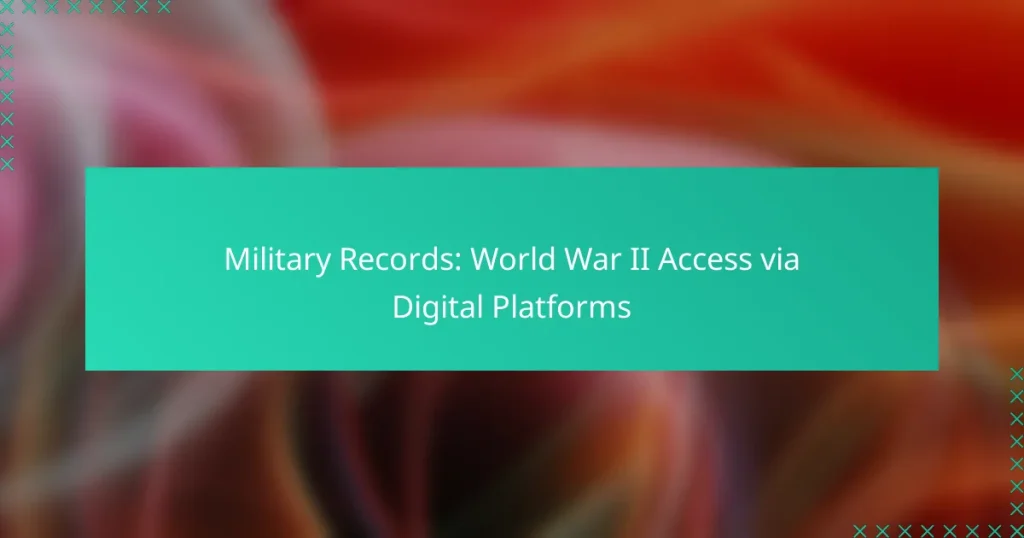Accessing World War II military records online is made easy through various digital platforms, such as the National Archives Catalog, Ancestry.com, and Fold3. These resources provide a wealth of information and unique features that streamline the research process, allowing individuals to efficiently locate and review historical military documents.

How to access World War II military records online?
Accessing World War II military records online is straightforward through various digital platforms. Key resources include the National Archives Catalog, Ancestry.com, and Fold3, each offering unique features and types of records.
National Archives Catalog
The National Archives Catalog provides a comprehensive collection of military records from World War II. Users can search for service records, unit histories, and official documents by entering specific names or keywords.
To access these records, visit the National Archives website and use the search function. Many documents are digitized and available for free, but some may require a visit to the physical archives or a request for copies.
Ancestry.com database
Ancestry.com offers a vast database of World War II military records, including enlistment records, draft registrations, and service records. This platform requires a subscription, but it often provides a free trial for new users.
When searching, utilize filters to narrow down results by service branch, location, or time period. Ancestry.com also allows users to build family trees, making it easier to connect military records with family history.
Fold3 military records
Fold3 specializes in military records and provides a user-friendly interface for accessing World War II documents. This platform features a wide array of records, including service records, pension files, and casualty lists.
A subscription is required, but Fold3 often offers discounts for veterans and their families. Users can search by name or browse through specific collections, making it a valuable resource for those researching military history.

What are the benefits of using digital platforms for military records?
Digital platforms for military records offer significant advantages, including ease of access and a wealth of information at your fingertips. These platforms streamline the research process, making it simpler for individuals to locate and review historical military documents.
Convenience and accessibility
Digital platforms provide unparalleled convenience, allowing users to access military records from anywhere with an internet connection. This eliminates the need for physical visits to archives or libraries, saving both time and travel expenses.
Many platforms are designed to be user-friendly, enabling even those with limited technical skills to navigate through records easily. This accessibility ensures that a broader audience can engage with military history and personal genealogies.
Comprehensive databases
Digital military record platforms often feature extensive databases that compile information from various sources, including service records, unit histories, and personal accounts. These comprehensive collections can cover millions of individuals, providing a rich resource for researchers and historians.
For example, platforms like Ancestry.com and Fold3 offer access to a wide range of World War II records, including enlistment papers and casualty lists, which can be invaluable for family history research.
Searchable records
One of the key benefits of digital platforms is the ability to search records using specific criteria, such as names, dates, and locations. This feature significantly reduces the time spent sifting through physical documents, allowing users to find relevant information quickly.
Many platforms also incorporate advanced search tools, such as filters and keyword searches, enhancing the efficiency of the research process. Users can easily narrow down results to find the exact records they need, making the exploration of military history more effective.
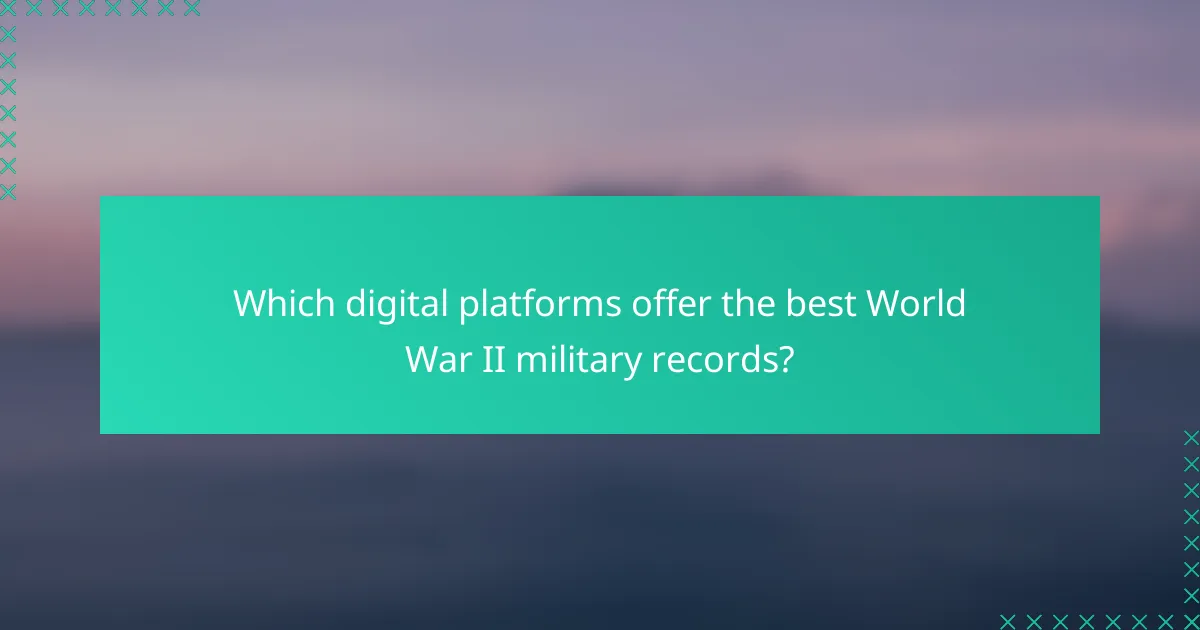
Which digital platforms offer the best World War II military records?
Several digital platforms provide access to World War II military records, each with unique features and resources. Key platforms include FamilySearch.org, MyHeritage military records, and Archives.gov, which offer extensive databases for research.
FamilySearch.org
FamilySearch.org is a free genealogy website that offers a wealth of World War II military records. Users can access service records, draft registrations, and enlistment records, which can help trace family history and military service.
To utilize FamilySearch, create a free account and navigate to the military records section. The platform allows users to search by name, location, and service details, making it easier to find specific individuals.
MyHeritage military records
MyHeritage military records provide a comprehensive collection of World War II documents, including enlistment records, military unit histories, and personal stories. This platform requires a subscription, but it offers advanced search features and historical context for users.
When using MyHeritage, consider taking advantage of its smart matching technology, which can connect you with other users researching similar ancestors. This can enhance your understanding of your family’s military background.
Archives.gov
Archives.gov, the official website of the U.S. National Archives, offers access to a vast array of World War II military records, including unit histories and personnel files. This resource is invaluable for researchers seeking official documents and historical data.
To access records on Archives.gov, use the search function to locate specific collections or browse by category. Many documents are digitized, but some may require a visit to physical archives for access. Be prepared to navigate various formats and potential fees for copies of certain records.
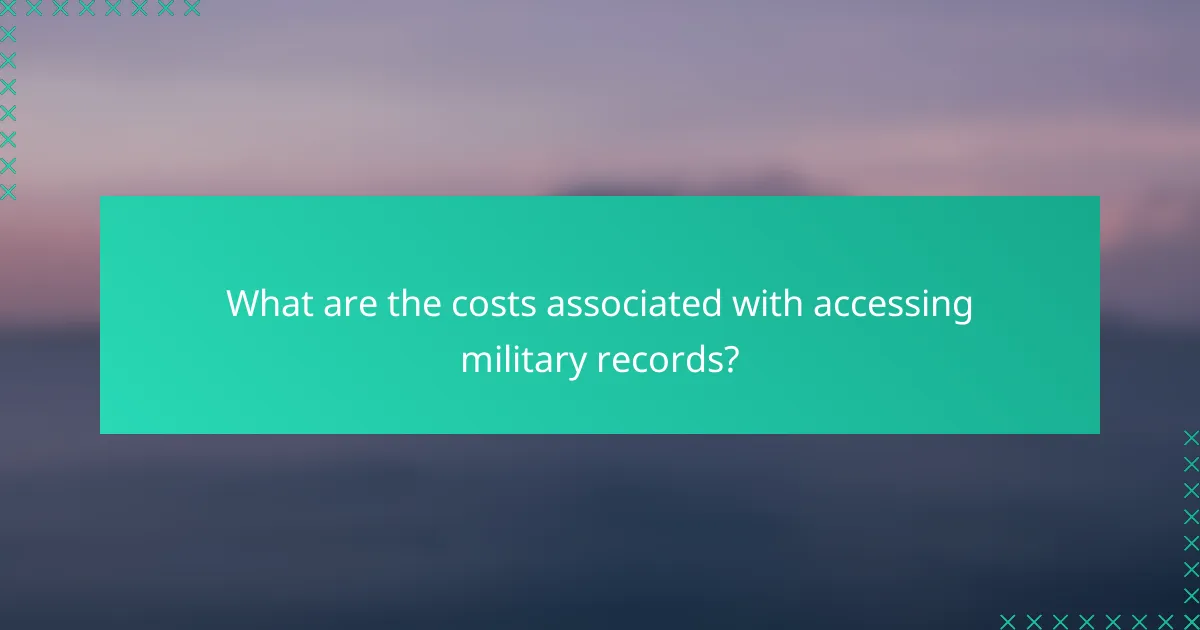
What are the costs associated with accessing military records?
Accessing military records, particularly from World War II, can involve various costs depending on the platform used. Users should consider both subscription fees and pay-per-view options when planning to obtain these records.
Subscription fees
Many digital platforms offer subscription models that provide unlimited access to military records for a monthly or annual fee. These fees typically range from around $10 to $30 per month, with discounts often available for longer commitments.
When choosing a subscription service, evaluate the breadth of records available and any additional features, such as historical context or search tools. Some platforms may also offer free trials, allowing users to assess value before committing financially.
Pay-per-view options
Pay-per-view options allow users to access specific military records without a subscription, charging a fee for each document retrieved. This can be a cost-effective choice for those who need only a few records, with fees generally ranging from $5 to $20 per document.
However, pay-per-view can become expensive if multiple records are needed. Users should weigh the total expected costs against subscription fees to determine the most economical approach for their research needs.
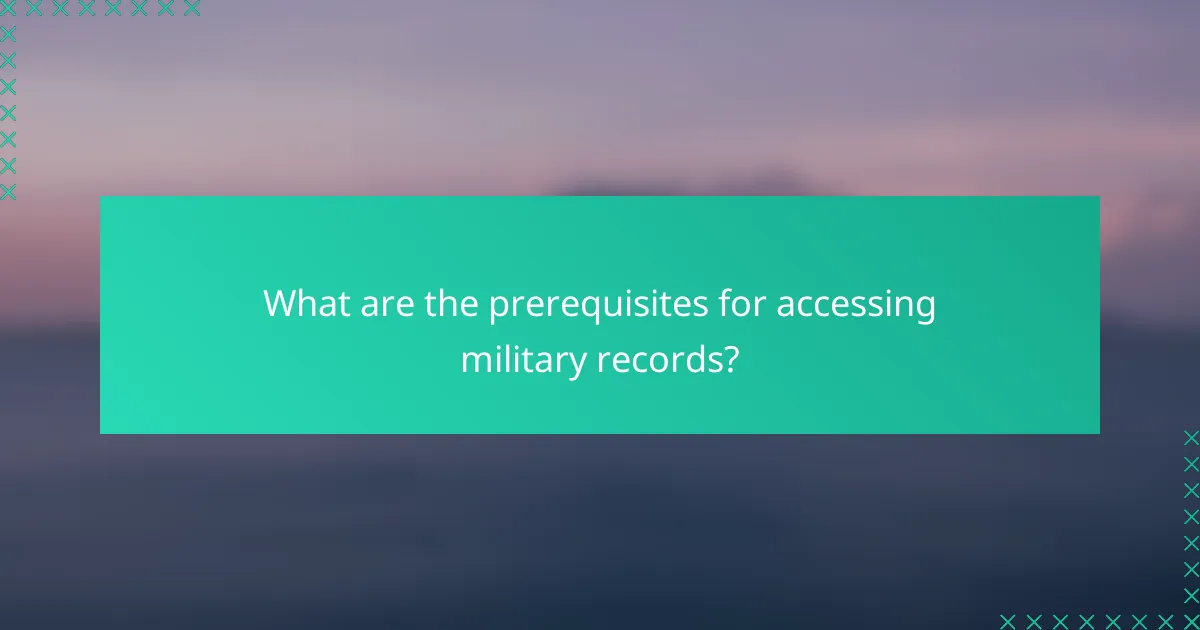
What are the prerequisites for accessing military records?
To access military records, particularly those from World War II, individuals must meet specific prerequisites that typically include registration with the relevant digital platform and verification of their identity. These steps ensure that sensitive information is protected and only accessible to authorized users.
Registration requirements
Most digital platforms housing military records require users to create an account. This process usually involves providing basic personal information such as name, email address, and sometimes a phone number. Some platforms may charge a fee for access, so be prepared to provide payment information if necessary.
When registering, ensure that you use a secure password and consider enabling two-factor authentication for added security. This helps protect your account from unauthorized access, especially when dealing with sensitive historical data.
Identification verification
Identification verification is a crucial step in accessing military records. Users may need to submit documents that confirm their identity, such as a government-issued ID or proof of relationship to a veteran if accessing specific records. This process helps maintain the confidentiality of the information.
Be aware that verification times can vary. Some platforms may provide instant access upon successful registration and verification, while others might take several days to process your documents. Always check the platform’s guidelines for specific requirements and expected timelines to avoid delays.
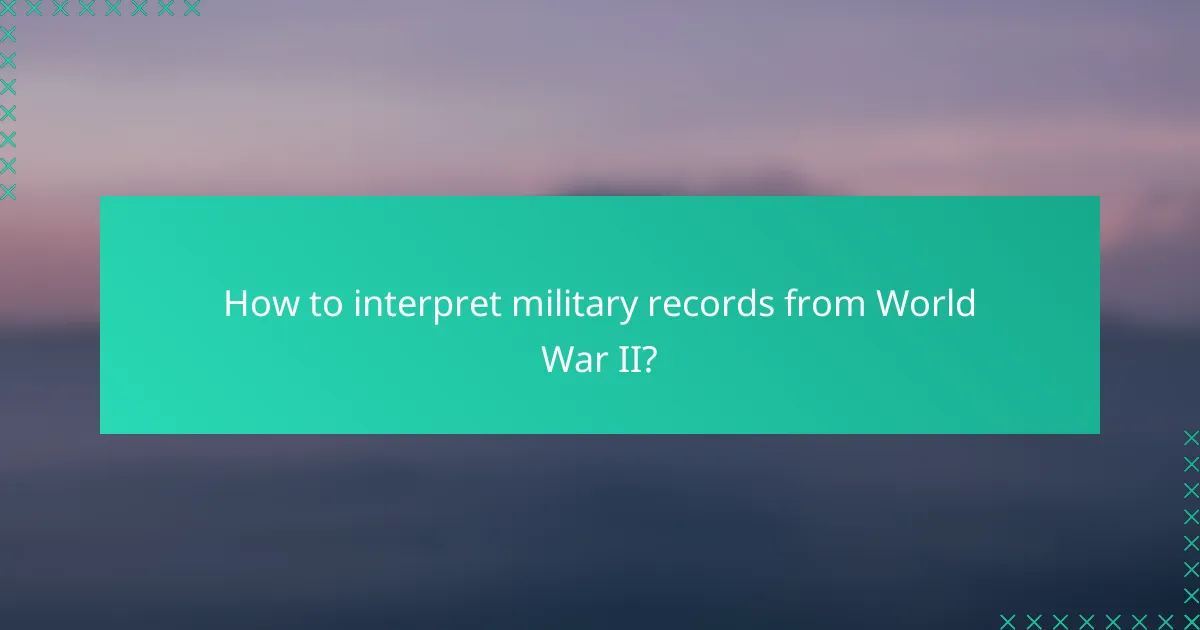
How to interpret military records from World War II?
Interpreting military records from World War II involves understanding the structure and terminology used in these documents. Familiarity with common abbreviations, service numbers, and the context of the records can significantly aid in extracting relevant information.
Understanding military jargon
Military records often contain specialized language that can be confusing. Terms like “MOS” (Military Occupational Specialty) or “AWOL” (Absent Without Leave) are common and crucial for understanding a service member’s role and actions. Familiarizing yourself with these terms can clarify the context of the records.
A helpful approach is to create a glossary of frequently encountered military jargon. This can serve as a quick reference while reviewing records. Online resources and military history websites often provide lists of common terms and their meanings.
Decoding service numbers
Service numbers are unique identifiers assigned to military personnel, and they can reveal important details about a service member’s branch, enlistment, and service history. For example, Army service numbers typically consist of a combination of letters and digits, while Navy numbers may follow a different format.
When interpreting service numbers, pay attention to the structure. For instance, the first digit may indicate the branch of service, while subsequent digits can provide information about the enlistment year. Understanding this can help you trace a service member’s military journey more effectively.
